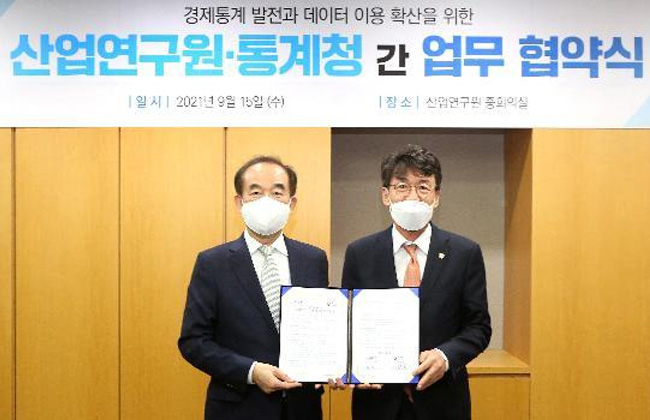In the second half of 2025 (H2 2025), the South Korean economy faces stiff headwinds, with macroeconomic factors worsening amid deepening policy uncertainties fueled by geopolitical developments. Among external factors, expanding investment in IT infrastructure across the world is the sole bright spot. Domestically, supply capacity is set to grow slightly, primarily in advanced industries and promising sectors, and investments in the digital transformation (DX) and green transformation (GX) are expected to continue apace. Korean firms are also poised to continue offshoring production to offset rising costs of producing and exporting goods at home, domestic firms’ overseas supply chains and production networks are going to keep evolving.
For the full report by the Flagship Industry Forecasting Task Force, click the download link above.

Hello. I’m Jae Yoon Lee,
Research Fellow and Director of the Office of Carbon Neutrality and Industrial Transition Research at the Korea Institute for Industrial Economics and Trade.
I’ll be discussing the outlook for South Korea’s 13 flagship industries in 2025.
For 2025, production is set to slow down in many of Korea‘s 13 flagship industries, saving only for a handful of IT-driven sectors,
due to escalating trade risks, a sluggish global economic recovery, and increased outsourcing overseas.
We expect export growth to fall and weak growth in domestic demand.
Overall, robust global demand for IT products should to support healthy production and exports of ICT devices, semiconductors, and displays.
The biotech and shipbuilding are likely to slow down in the second half of the year,
but are nonetheless slated to post positive growth year-over-year (YoY).
The automotive, machinery, steel, oil refining, home appliances, and secondary batteries sectors are expected to remain in recession during the first half of the year due to sluggish domestic and global demand.
We do however anticipate a modest improvement in the petrochemicals industry in the second half of the year, and a full-scale recovery could be in the cards post-2026.
Now, let's take a closer look at the outlook for each of Korea’s 13 flagship industries in the second half of 2025 through detailed graphs.
First, let’s examine each industry’s export outlook for the second half of 2025.
Despite continued export growth in emerging industries such as IT and biotech,
exports of the 13 flagship industries in the second half of 2025 are expected to decline by 2.3% year-on-year
due to prevailing negative factors, such as high US tariffs, intensifying external uncertainties, and increased outsourcing of production abroad.
Due to the reverse base effect and other contributing factors, by the time the first half of 2025 comes to a close,
overall exports are likely to have tumbled by 1.9%, resulting in an annual export decline of 2.1% compared to the previous year.
Among the machinery industries, the shipbuilding sector should expected maintain its growth trajectory in exports (3.4%) in the second half thanks to deliveries of high-value LNG carriers.
However, exports of automobiles (-11.4%) and machinery (-5.8%) are expected to decline further in the second half of the year due to US tariffs and sluggish global demand.
As a result, annual exports in the machinery sector — which grew by 0.6% last year — are expected to fall by 5% in 2025.
In the materials sector, lower oil prices, higher US tariffs,
and weakening global demand are expected to result in weak exports across all subsectors throughout the year.
Overall, sectoral exports look set to plummet by -9.4% in 2025, after falling by -1.2% in the previous year.
After a 29.4% surge in 2024, exports for the IT industry and emerging new sectors are expected to continue growing by 4.7% in 2025,
supported by strong global IT demand driven by AI adoption, an increasing share of high-value semiconductors,
and the growth of promising sectors such as biosimilars and energy storage systems (ESS).
However, risks such as tariffs, rapid Chinese growth, and expanded outsourcing are expected to act as constraints on export growth.
Next is the domestic demand outlook for Korea’s 13 flagship industries for the second half of 2025.
The overall decline trend in domestic demand for the 13 flagship industries should soften somewhat in the second half of 2025, aided by improved consumer sentiment.
However, sluggish construction investment and weak domestic and global growth will continue to constrain demand growth.
In the machinery sector, domestic demand for automobiles (2.1%) is expected to increase in the second half of the year as domestic automakers turn their focus to the domestic market.
But domestic demand for general machinery (-1.7%) is expected to decline in the second half of the year due to the slump in the construction and manufacturing sectors.
In the materials sectors, domestic demand for petrochemicals is expected to rebound by 6.3% in the second half.
However, overall annual demand growth is likely to be negative (-0.2%).
And due to weak construction investment, steel demand is also expected to fall (-4.7%). Domestic demand for textiles should remain flat (0.7%).
In the IT industry and emerging new sectors, new product launches and improved electric vehicle (EV) sales are expected to drive a rebound
in domestic demand for ICT devices (5.5%) and secondary batteries (6.8%) in the second half of 2025.
However, domestic demand growth in the biohealth sector is projected to decline by nearly three percentage points in the second half of 2025 due to the base effect,
but overall expanded policy support will allow the sector to see continued annual demand growth of 2.2%.
Next is the production outlook for the Korea’s 13 flagship industries in the second half of 2025.
Production in most sectors should continue to tumble in the second half of 2025,
following downturns observed in the first half of the year as exports stumble and domestic demand recovers only modestly.
In the machinery sectors, annual production is expected to decline for the second consecutive year,
as the decline trend in production of automobiles (-4.4%) and general machinery (-3.5%) worsens in the second half amid sluggish exports and domestic demand.
Although production in the shipbuilding sector is projected to drop by 5.8% in the second half of the year,
the industry should post positive overall annual growth (5.0%) as production is normalized.
In the materials sector, continued export sluggishness and a restrained domestic recovery are expected to result in further production declines
in the steel (-1.3%), refining (-2.2%), and textiles (-1.4%) subsectors during the second half of the year.
However, the petrochemicals (-0.4%) industry could see an uptick in production (3.5%) due to improved product spreads and higher capacity utilization.
Although production growth in the emerging IT industries is expected to slow in the second half of 2025 compared to the first,
increased exports should bolster production in the ICT devices (2.1%), semiconductors (2.3%), and biotech (3.1%) subsectors.
On the other hand, production in the home appliances (-0.5%) and secondary batteries (-2.2%) sectors is expected to fall again in the second half of the year as firms outsource production abroad.
Finally, let’s take a look at outlook for imports in Korea’s 13 flagship industries for the second half of 2025.
Despite rising imports of IT products, total imports in the 13 flagship industries are expected to decline by 0.5% YoY
due to slack domestic demand in the machinery and materials sectors and falling unit prices caused by an increase in low-cost imports.
In the machinery sectors, overall imports of automobiles are expected to tick downward due to increased imports of low-cost EVs,
while imports of general machinery should remain flat amid weak recovery in the manufacturing sectors.
However, shipbuilding imports are projected to increase due to localization of equipment.
In the materials sectors, imports of steel are expected to plunge as domestic demand falters and new restrictions on imports take effect.
Imports of refined oil are also likely to dip as unit prices fall.
However, with improving domestic demand and an increasing influx of low-cost imports, imports of petrochemicals and textiles are expected to grow slightly.
In the emerging IT industries, imports of IT products and home appliances are expected to increase in the second half of the year,
driven by improved consumer sentiment. Imports of semiconductors used in the development of advanced technologies are also projected to continue,
while the decline in secondary battery imports is expected to slow significantly due higher domestic demand for imported batteries.
이메일 수집방지를 위해
아래 보안문자를 입력해 주세요

아래 보안문자를 입력해 주세요

담당자 정보를 확인해 주세요.
연구과제 제안이 접수되었습니다.
신청이 접수되었습니다.


코로나19 발생 이후 대부분의 고용 관심사가 항공 및 여행서비스, 음식·숙박 서비스 등 주로 서비스 업종에 집중된 상황에서 본 연구는 최근 그 중요성이 강조되고 있는 제조업의 고용변화를 살펴보았다. 분석에 따르면, 코로나19 이후 제조업 고용은 비교적 큰 충격 없이 빠르게 회복하는 모습을 보이고 있다. 제조업 고용은 서비스업에 비해 큰 충격 없이 유지되고 있고, 코로나19 직후 2020년 상반기에 약간 하락하였지만 하반기부터 회복 추세를 보이고 있으며, OECD 주요국의 제조업과 비교하여도 일본과 함께 고용 충격이 비교적 작게 나타나고 있다. 그러나 전반적으로 양호한 고용 성적에도 불구하고 제조업 내 특성 별로는 차이가 나타나는 것으로 보인다. 종사상 지위 별로 보면, 임시·일용직, 고용원이 있는 자영업자에서 고용 충격이 상대적으로 크게 나타났고, 상용직과 고용원이 없는 자영업자는 큰 충격이 없는 것으로 나타났다. 제조업 규모별로는 300인 이상의 경우 코로나 발생 초기 약간의 충격 이후 고용이 빠르게 반등하면서 코로나 이전보다 고용이 더 증가한 반면, 이보다 작은 규모의 제조업체들의 경우 고용 회복이 더디게 나타나고 있다. 고용의 중장기, 단기 추세선을 비교한 결과 제조업 업종에 따른 차이를 보였다. 코로나 발생 이전 3년간의 추세선을 2020년 1월부터 연장한 선과, 2020년 1월부터의 실제 자료를 이용한 단기 추세선을 비교한 결과, 의약품은 코로나19 발생 이전부터 시작하여 코로나19 발생 이후에도 견조한 증가세를 유지하고 있으며, 전자부품·컴퓨터, 기타운송장비, 가구는 코로나19 이후 오히려 고용 추세가 개선되었다. 그러나 다수 업종은 코로나 발생 이후 고용이 하락하였는데, 특히, 비금속광물, 1차금속, 금속가공 분야나 인쇄·기록매체 업종에서 하락이 상대적으로 크게 나타났다.
담당자 정보를 확인해 주세요.
inform@kiet.re.kr이름 : 박홍서
전화번호 : 044-287-3811
정보의 무단수집 방지를 위해
아래 보안문자를 입력해 주세요.

비밀번호를 입력해주세요.
[전지적키에트시점] (Eng sub)심상치 않은
국내 대기업 움직임??
KIET 시점에서 보는 미래 로봇 산업 전망은
어떨까요?
경제전문가가 알려드립니다!
(산업연구원 박상수 실장)